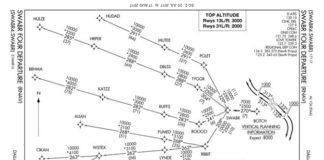Reader David Novelli asked an innocent but probing question. His primary airport has an approach that says if the local altimeter setting is unavailable you should use one from a nearby field and adjust the minimums. We’ve all seen that, although few of us have actually had to take advantage of it.
Philosophically digging deeper, Novelli’s question was what to do when both the primary and the secondary airport aren’t reporting an altimeter. This yielded some interesting discussions of both the legal and the practical that are just the stuff we’re known for.
The Real Answer
Look at any approach in the U.S. It’ll have one of three different notes about altimeter settings. First, it might have no note. Next, it might say that if an altimeter setting is not available, the approach is unusable. Last, it might say that if the local altimeter setting is not available, you should use one from a nearby airport.
We discussed these scenarios with our regs guru, Mark Kolber. Let’s look at them one at a time. As we do, it’s important to note that you must have a certified altimeter source for an approach. Per AIM 5-4-5.a.4. if you don’t have one, the approach is unusable.
Taking the second case first, the note saying the approach is NA without a local altimeter just restates the requirement. That, however, applies to the first case, too. Some approaches have the note, others, sometimes at the same airport, don’t. Doesn’t matter—no altimeter setting means no approach.
That leaves the last case, where you’re authorized to use a nearby altimeter setting. That’s pretty clear, but is the edge case that makes one wonder, as reader Novelli did, what to do when both are unavailable. Well, the AIM doesn’t really make a distinction. So, if you don’t have a certified and authorized altimeter setting, you can’t fly the approach. That’s the answer and we could stop right there. But, we like to dig a lot deeper.
Certified?
Not all that long ago, we didn’t have AWOS or ASOS equipment. The local FBO or airport management often took on the role of providing airport advisories. You’d call on Unicom and a person sitting in the FBO or airport office would tell you of any known traffic and give you the local altimeter setting read from an instrument right there in the office.
Occasionally, you could even get a reasonably complete report of current conditions, much like you get from the automated systems today. The person who provided that was a certified weather observer, meaning not everyone could do it. In the case of the altimeter setting, the equipment also needed to be certified.
That’s all still true, but we seldom see it. Nonetheless, the possibility exists and you might occasionally encounter an observer who can report the altimeter from a certified instrument. So, before just giving up, it’s at least worth a call on Unicom. Don’t expect an answer, though.
But, What If?
So, now you know the back story and the requirements, but let’s dig into this even further, just to satisfy some intellectual curiosity as we did when discussing the issue with reader Novelli. Take any case where you can’t get a usable altimeter setting. The regs say the approach is unusable. Fine. But, what if it’s an emergency and you really have to land there and then?
Well, in an emergency, you can do anything you want—you need only justify it to the feds later if asked. This might be a good example of that. Keep in mind that this is an intellectual discussion about a “what if” situation. There’s no official guidance, so your answer might well be different from ours. Here’s what we said.
Do not even think out all this if the weather is right down to minimums; the potential accuracy of the guesstimated altimeter setting when you’re going to rely on it to go all the way down should scare the guano out of you. The prerequisite for the following ways to guesstimate an altimeter setting is that the weather is comfortably above minimums. More on that in a bit.
First, we’d see if we could get an answer from somebody on the ground. Perhaps there’s a pilot who might answer. Ask him or her to set the altimeter to the field elevation and read the setting to you. Now, every altimeter has some error, perhaps even as much as a couple hundred feet. So, take that into account if you’re going to use this setting, probably by adding as much as 200 feet to the minimums. But, other than this suspect accuracy from the source, you know you’re getting a local setting, so with the safety adjustment, you should have an acceptably high confidence in the setting.
Next, you could get settings from nearby airports. If there’s a geographic trend, like falling altimeter to the east and rising to the west, you should take that into account, adjusting for your location. Then, use this remaining information to make a comfortable estimate of the altimeter at the desired field.
Of course, there are cautions. If it’s mountainous and the desired airport is in a valley with other airports in other valleys, you shouldn’t have a very high confidence in the guesstimated altimeter setting. However, if there aren’t significant terrain considerations or nearby altimeter settings are reasonably consistent, the risk of the estimate being far off is probably acceptably low.
Note our prerequisite that the weather is “comfortably” above mins. We would take the total deviation from the highest nearby altimeter to lowest, double it, then convert to feet and add that to the mins. If the ceiling is above that, we’d be comfortable proceeding.
So, say the altimeter range was 29.94 as a low and 29.98 as a high. That’s a difference of .04. Double that to .08. That’s 80 feet. If published mins were 400 feet AGL, we’d use 480 as an absolute hard deck, although we’d start squirming below even about 600 feet.
A couple more notes are in order: If you have solid terrain information (GPWS, for instance, or TAWS) or even a radar altimeter, watch those very closely while on approach. Those would likely give you a little extra confidence. Oh, last, we should repeat that this hypothetical discussion is only meaningful in the context of an emergency under Part 91 and not for hire. It’s our opinion that any for-hire situation pushes this too far from defensible actions to even consider.
Interesting Discussion
Let’s wrap by repeating a few important points. First, without a certified, authorized altimeter setting for an approach, that approach is not available. Period.
We followed that conclusion with an intellectual exercise of what we might do if we absolutely had to fly an approach and there wasn’t a usable altimeter setting available. The value of that discussion was mostly a mental exercise to better understand altimetry while thinking through the various considerations. You can then file all this away as a practical solution should such an unlikely emergency arise. Until then, lacking an altimeter setting, go elsewhere.




